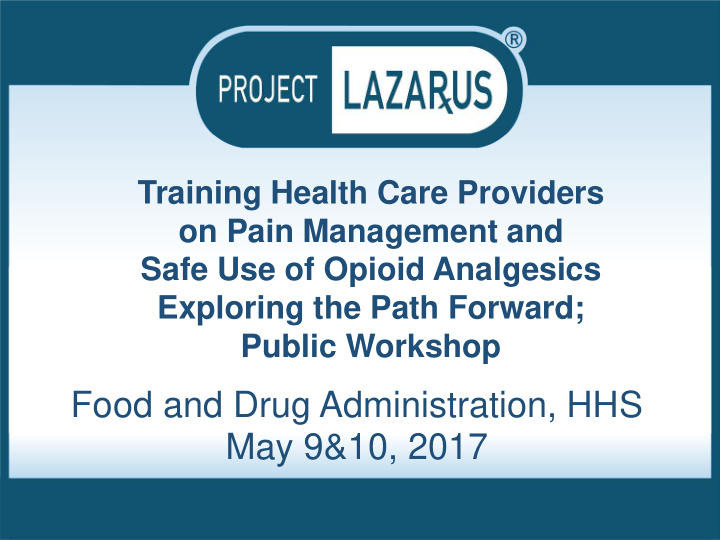



Training Health Care Providers on Pain Management and Safe Use of Opioid Analgesics Exploring the Path Forward; Public Workshop Food and Drug Administration, HHS May 9&10, 2017
Wilkes County Wake Forest Evaluation Physician education has been conducted by the medical director of the County Health Department, who visited half the physicians registered with the Drug Enforcement Administration in the county, representing 70% of office practices, a strategy that others have called “academic detailing. Albert et al Pain Medicine 2011; 12: S77–S85 Wiley Periodicals, Inc. Most continuing medical education on pain management is didactic. Source: 2011 Project Lazarus Health Director Survey
Impact of CPI “ Has your comfort level with treating chronic pain patients changed as a result of being involved in CPI? “ Yes No Don't Know DK • Already had philosophy and was using 7% 0% pain contract YES • CPI validated those tactics and NO 50% provided documentation tools 43% • Feels like now there's a guideline explaining all that needs to be done. • Feels 'covered' if following guidelines. • Still does not like treating CP; prefers to refer to pain clinic.
Provider er P Per ercep eptions of Patient C t Change
Womack Army Medical Center Opioid Risk k Mitigation Plan Operation OpioidSafe PRIMARY PREVENTION EPIDEMIOLOGIC SECONDARY PREVENTION SURVEILLANCE • Risk Stratification • Education of patient and family on • Urine Drug Screen identification and treatment of • Account for all patients who • Sole Provider Agreement overdose entered Risk Mitigation • Opioid Physical Profile • Dispense naloxone program and their status • Restricted Refill Duration • Opioid detoxification • Surveillance of overdose • Patient and Family Education (buptenorphine) rates, fatal overdoses, and • Nurse Case Management all-cause mortality COMMUNITY EDUCATION COALITION BUILDING • Integrate into safety stand-down days at Battalion level • Coordinate with stakeholders within • Instruction to cadre and staff of Warrior the community Transition Brigade • Have Army Substance Abuse Program • Education to unit medics on opioid overdose (ASAP) implement Operation and treatment OpioidSAFE into their program • Presentation of Operation OpioidSAFE video • Coordinate with substance abuse to all members receiving curriculum treatment centers
Operation OpioidSafe, US Army Ft. Bragg, NC Overdose Rate 15 OD’s per 400 soldiers to 1 per 400. • 2008 and 2009 non-fatal OD’s were 17 per 1000 soldiers. • That rate dropped to 1.4 per 1000 soldiers • according to WTU Brigade surgeon statistics. Naloxone 2008 – t he “ st op, p, look and d list en m om ent ” Abuse deterrent formulations - refills A systematic approach to pain management emphasizing • risk stratification • risk mitigation • provider education • other modalities to/with opioids for pain management Resulted in a reduction of opioid prescribing with decreased healthcare utilization and improvement in patient satisfaction
Prescribe to Prevent – Asheville NC - MAHEC N=32 Strongly Agree Undecided Disagree Strongly Rating Agree Disagree Average 5 4 3 2 1 Presentation 59% 31% 3% 0% 3% 4.48 positively impacted my ability to provide services to patients and/or clients Define the 56% 44% 0.0% 0.0% 0.0% 4.56 components of a successful community-based prescription opioid overdose prevention program
Who is responsible for ensuring the client/patient understands how to take prescribed medication? 100.0% 90.0% 80.0% 70.0% 60.0% 50.0% 93.8% N=32 40.0% 78.1% 75.0% 62.5% 30.0% 20.0% 10.0% 18.8% 0.0% The prescriber The nurse/ The pharmacist The client/patient Other medical assistant
How do you ensure that clients/patients understand how to take their medication correctly? 50.0% 45.0% 40.0% 35.0% 30.0% 25.0% 42.9% 20.0% 35.7% N=14 15.0% 10.0% 14.2% 5.0% 7.1% 0.0% When I prescribe a medication I When I prescribe a medication I When I prescribe a medication I When I prescribe a medication I explain how to take the expect the client/patient to ask provide written or printed explain the instructions verbally medication, but do not feel it is questions if they are unsure how instructions for the client/patient and then ask my client/patient to necessary to have the to take it. on how to take the medication. repeat the instructions back to client/patient repeat my me to ensure he/she understands instructions. how to take the medication safely.
UNC Injury Prevention Research Center 9% lower 3% lower Overdose Mortality IMMEDIATE IMPACTS OF INTERVENTION STRATEGIES ED Visits for Overdose Apostolos Alexandridis, MPH UNC Injury Prevention Research Center aaa@unc.edu +1-313-799-2447
IMPACT in NC • Most effective strategies to immediately reduce overdose rates were prescriber education related to pain management and addiction treatment • Policies designed to limit the amount of opioids dispensed in hospital emergency departments. • Greater utilization of addiction treatment showed a delayed reduction in ED-related overdose visits. • State and local strategies to prevent overdose should consider interventions within the healthcare system, and use community-based coalitions to build and sustain support for these interventions
Lessons Learned • Where there is a will, there is a way • Initially more push, now more pull • Training alone is not sufficient • Support • Integration • Team based care • Available, accessible and covered modalities for pain management Failure to treat is mistreatment!
www.projectlazarus.org Fred Wells Brason II fbrason@projectlazarus.org Robert Wood Johnson Community Health Leader Award 2012
Recommend
More recommend